Lemon Zest Know-How!
There’s a lot more to zesting a lemon than meets the eye. First, it’s good to know exactly what IS lemon zest (or the zest of any citrus fruit)? It’s the outermost layer of the peel, known as the “flavedo.” This layer contains loads of natural oils that are full or flavor, but aren’t as acidic as the tart juice.
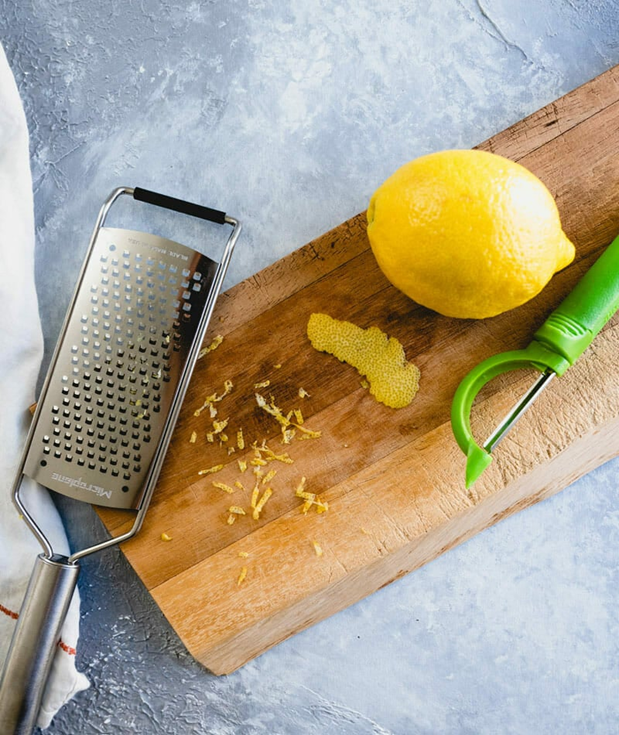
Not only does lemon zest contribute a special flavor, research shows lemon peels have many health benefits because of fiber, vitamin, and antioxidants. These all help your teeth, heart, and immune system. Current studies are also showing these fruit peels help fight cancer.
Besides wonderful flavor (that can be even stronger than that of the juice) and health benefits, you get some acidity. Acidity cuts greasiness and heaviness and gives food a fresh, clean taste.
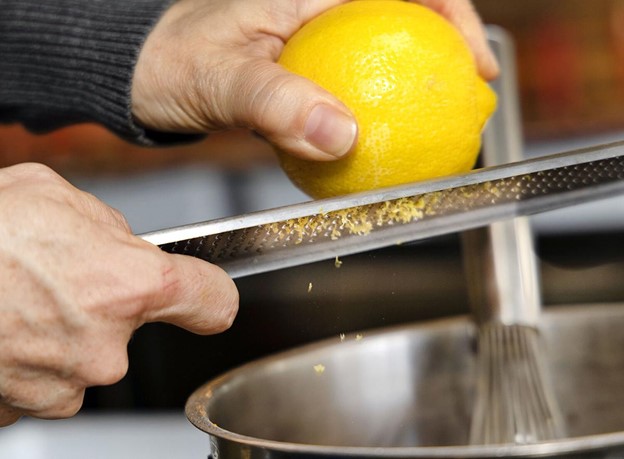
But back to more about what lemon zest is: As mentioned, it’s the thin, colored outer layer of the skin. But it DOES NOT include the bitter white underlayer. When zesting, you have to know when to stop—good zesting calls for a light hand.
There are three basic kinds of citrus zest that are called for in recipes: peels, julienned strips, and fine zest. Sturdy peels are useful in braises or as a garnish for drinks, and are easy to create with a standard vegetable peeler.
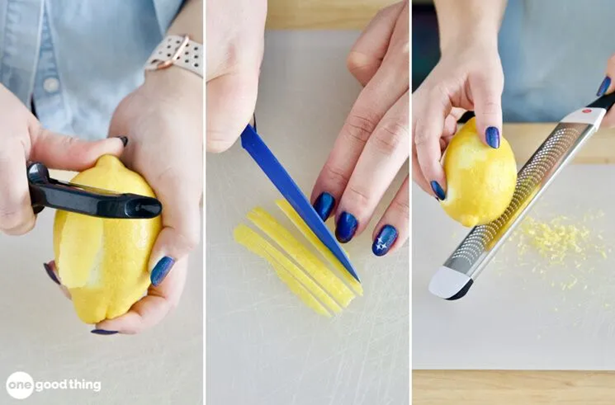
Julienned (or thinly sliced) strips are good in sauces and make a pretty garnish, and you can make them by thinly slicing a larger piece of peel, or using a zester tool like this. And lastly, fine zest delivers a punch of citrus flavor to dressings, desserts, and baked goods. It’s easy to achieve with the help of a microplane or fine grater.
When you don’t have a lemon to zest, you can replace each teaspoon of lemon zest called for in your recipe with 1/2 teaspoon of lemon extract or two tablespoons of lemon juice. It will give you the closest flavor match possible.
And it’s true that you can buy dried lemon zest at your local grocery store. It's sold alongside other spices and dried herbs or seasonings. But just know that it won’t have the same punch as zest from a fresh lemon. It may even carry on off-taste as a result of its processing and time sitting on the grocery store shelf.
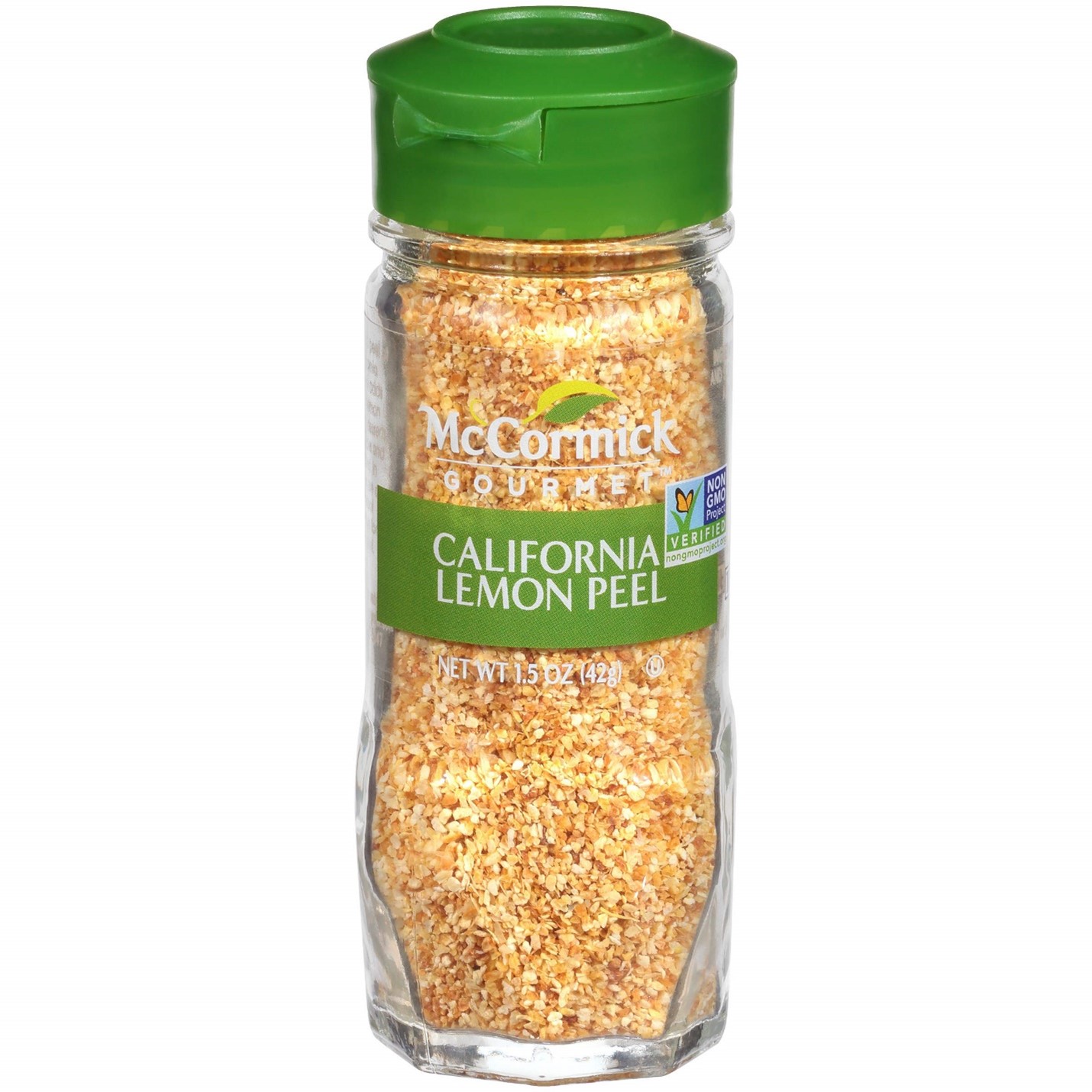
So, for all the above reasons, do try to keep fresh lemons on hand. They’re best kept in the fridge (never on the kitchen counter). Recommendations to help them last 2 or more weeks include:
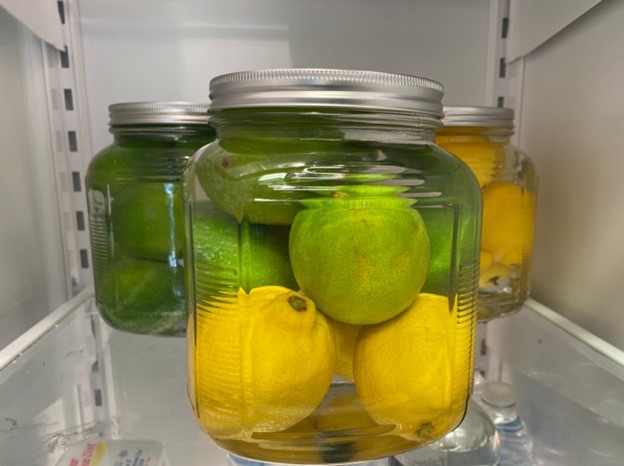
My very favorite technique for lemon storage is placing them (along with limes and oranges—organic, if possible) in a large lidded glass container filled with pure water. This not only looks pretty in your refrigerator, but you can reuse the water in cooking or in your smoothies. This approach will keep citrus fresh (with soft rinds) for up to 4 weeks!
I’ll close with a recipe that calls for lemon zest. Notice the difference it makes in the flavor of the vegetables. Zest really does take food to a whole new level. (Many thanks to Amber of www.slimpickinskitchen.com for this easy and wonderful recipe!)
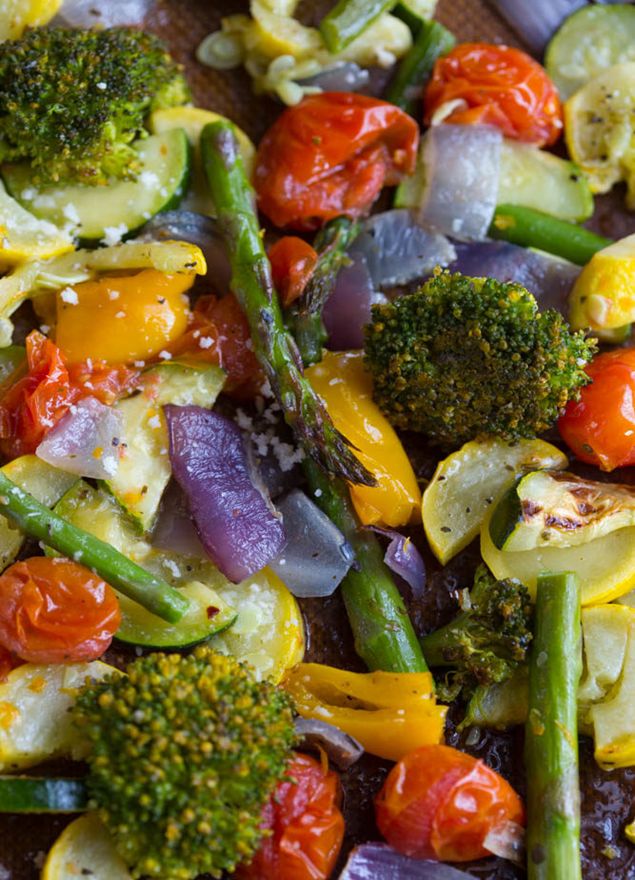
8 cups mixed fresh vegetables of choice: broccoli, zucchini, squash, mini bell peppers, grape tomatoes, whole garlic cloves etc.
1/2 teaspoon Italian seasoning
1/2 teaspoon fine sea salt
freshly cracked black pepper to taste
3 tablespoons + 2 teaspoons extra virgin olive oil divided
3 tablespoons freshly grated Parmesan cheese
1/2 tablespoon freshly grated lemon zest (from one small lemon)
juice from 1/2 a lemon
Directions:
Add Recipe to Cook'n

Not only does lemon zest contribute a special flavor, research shows lemon peels have many health benefits because of fiber, vitamin, and antioxidants. These all help your teeth, heart, and immune system. Current studies are also showing these fruit peels help fight cancer.
Besides wonderful flavor (that can be even stronger than that of the juice) and health benefits, you get some acidity. Acidity cuts greasiness and heaviness and gives food a fresh, clean taste.

But back to more about what lemon zest is: As mentioned, it’s the thin, colored outer layer of the skin. But it DOES NOT include the bitter white underlayer. When zesting, you have to know when to stop—good zesting calls for a light hand.
There are three basic kinds of citrus zest that are called for in recipes: peels, julienned strips, and fine zest. Sturdy peels are useful in braises or as a garnish for drinks, and are easy to create with a standard vegetable peeler.

Julienned (or thinly sliced) strips are good in sauces and make a pretty garnish, and you can make them by thinly slicing a larger piece of peel, or using a zester tool like this. And lastly, fine zest delivers a punch of citrus flavor to dressings, desserts, and baked goods. It’s easy to achieve with the help of a microplane or fine grater.
When you don’t have a lemon to zest, you can replace each teaspoon of lemon zest called for in your recipe with 1/2 teaspoon of lemon extract or two tablespoons of lemon juice. It will give you the closest flavor match possible.
And it’s true that you can buy dried lemon zest at your local grocery store. It's sold alongside other spices and dried herbs or seasonings. But just know that it won’t have the same punch as zest from a fresh lemon. It may even carry on off-taste as a result of its processing and time sitting on the grocery store shelf.

So, for all the above reasons, do try to keep fresh lemons on hand. They’re best kept in the fridge (never on the kitchen counter). Recommendations to help them last 2 or more weeks include:
- placing them in the crisper drawer or on a shelf
- keep them in a sealed container (there are even specialty produce keepers for this purpose)
- or a resealable plastic bag.

My very favorite technique for lemon storage is placing them (along with limes and oranges—organic, if possible) in a large lidded glass container filled with pure water. This not only looks pretty in your refrigerator, but you can reuse the water in cooking or in your smoothies. This approach will keep citrus fresh (with soft rinds) for up to 4 weeks!
I’ll close with a recipe that calls for lemon zest. Notice the difference it makes in the flavor of the vegetables. Zest really does take food to a whole new level. (Many thanks to Amber of www.slimpickinskitchen.com for this easy and wonderful recipe!)

Lemon Paremsan Roasted Vegetables
Ingredients:
8 cups mixed fresh vegetables of choice: broccoli, zucchini, squash, mini bell peppers, grape tomatoes, whole garlic cloves etc.
1/2 teaspoon Italian seasoning
1/2 teaspoon fine sea salt
freshly cracked black pepper to taste
3 tablespoons + 2 teaspoons extra virgin olive oil divided
3 tablespoons freshly grated Parmesan cheese
1/2 tablespoon freshly grated lemon zest (from one small lemon)
juice from 1/2 a lemon
Directions:
1. Preheat oven to 425 degrees (F).
2. Clean vegetables and chopped into large chunks and uniform pieces. Cut broccoli into florets, slice zucchini and squash into half-moons, trim asparagus and cut into thirds, half then quarter onions, and leave grape tomatoes and garlic cloves (w/ skin) whole.
3. Place all vegetables, except garlic, in a single layer onto one or two large baking sheets, sprinkle with salt, pepper, Italian seasoning, and drizzle with 3 tablespoon olive oil then toss to combine. Add garlic cloves to one corner of a baking sheet then drizzle each clove with 1 teaspoon olive oil.
4. Place in the oven and roast for 8 minutes, toss, then continue to cook for 5-7 minutes more or until tomatoes have burst and veggies are lightly golden brown.
5. Take out of the oven, remove garlic cloves from baking sheet, immediately top roasted vegetables with freshly grated Parmesan cheese, lemon zest, and the juice of half a lemon and toss.
6. Carefully remove garlic from skins, lightly chop, then toss roasted garlic with the Lemon Parmesan Roasted Vegetables.
7. Serve immediately and enjoy!
2. Clean vegetables and chopped into large chunks and uniform pieces. Cut broccoli into florets, slice zucchini and squash into half-moons, trim asparagus and cut into thirds, half then quarter onions, and leave grape tomatoes and garlic cloves (w/ skin) whole.
3. Place all vegetables, except garlic, in a single layer onto one or two large baking sheets, sprinkle with salt, pepper, Italian seasoning, and drizzle with 3 tablespoon olive oil then toss to combine. Add garlic cloves to one corner of a baking sheet then drizzle each clove with 1 teaspoon olive oil.
4. Place in the oven and roast for 8 minutes, toss, then continue to cook for 5-7 minutes more or until tomatoes have burst and veggies are lightly golden brown.
5. Take out of the oven, remove garlic cloves from baking sheet, immediately top roasted vegetables with freshly grated Parmesan cheese, lemon zest, and the juice of half a lemon and toss.
6. Carefully remove garlic from skins, lightly chop, then toss roasted garlic with the Lemon Parmesan Roasted Vegetables.
7. Serve immediately and enjoy!
Recipe formatted with the Cook'n Recipe Software from DVO Enterprises.
 Alice Osborne
Alice Osborne
Weekly Newsletter Contributor since 2006
Email the author! alice@dvo.com
